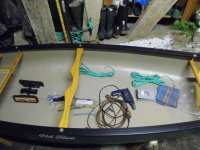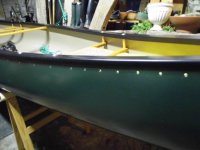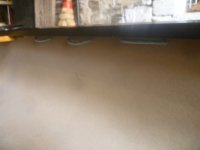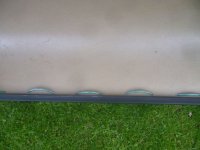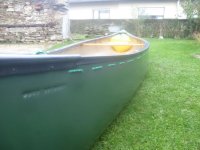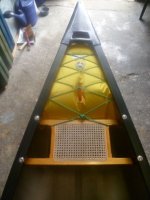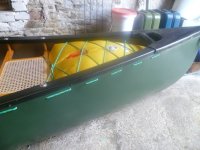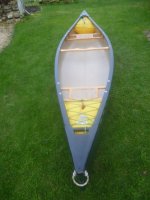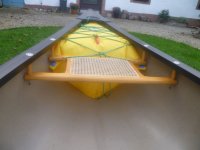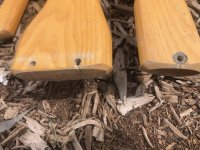- Joined
- Mar 12, 2024
- Messages
- 7
- Reaction score
- 2
After years of waiting I picked up my first boat last fall, I got a 2008 NovaCraft Prospector 17 in royalex. Finding a good condition prospector in AZ took a long time and I'm pleased with the boat. It has one small (~4 inch) cold crack but otherwise is in excellent condition.
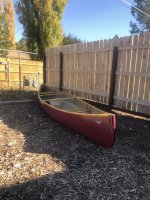
I've been reading through a lot of old posts on repair and maintenance of canoes, but would love to get some people's input to make sure I'm not missing anything important before I start working on my boat in the next few weeks. For reference these are the posts I've been primarily looking through
As well as some others about gunwale finishing and whitewater outfitting both on this site and others.
This boat will primarily be used for river tripping in the western US this summer, and then in AK next year and beyond as I will be starting a new job there before too long. As such it will encounter a fair bit of whitewater and I'm planning on installing whitewater outfitting and skid plates to preserve the canoe.
Now finally on to what I am looking for advice on
1. Repairing the cold crack:
Here is my plan please let me know if I'm missing anything
-remove the gunwales (I'm going to take them off to re-finish them anyways)
-drill a hole in the bottom of the crack with a 1/8 inch drill bit
-widen the crack (I'm planning on using a hacksaw since the crack is so short)
-bevel the crack (I don't have a dremel so I'm going to try and use a sharp chisel instead)
-sand the bevel
-tape the outside with packing tape, fill with g-flex, tape the inside, squeegee bubbles out of the crack
-drill out the holes in the hull a little to allow contraction and expansion
The cold crack originated at one of the deck plates. Since the NovaCraft wooden deck plates sit inside the hull past the end of the inwales should I move the mounting screw of the deck plate to not sit over the cold crack or is it fine to drill through the repaired crack?
2. Skid plates
- Use dynell cloth cut on a bias and g-flex mixed with graphite to make the skid plates
-Tape everything up really nice beforehand, and apply a release film over the top
- Use a roller to press the g flex into the dynell
-Remove tape and release film after the g flex is done dripping but before it cures
With the graphite in the epoxy does the skid plate have to be black? or can I color match to the hull?
How much will the dynell stretch once I wet it with epoxy? How much of a buffer should I give myself with my tape?
Do I need special sheers to cut the dynell like I would kevlar? What have people used for cutting out their plates in the past?
3. Refinishing the gunwales
-I'm planning on using tung oil rather than varnish because since this boat will see river duty the gunwales are more likely to get scuffed and I'd rather have to do more regular maintenance that is easier than deal with hard to fix scuffs and chips
4. Whitewater outfitting
- I'm planning on using the Mike Yee tandem kit.
Do people think it is better to use HH-66 vinyl adhesive or the Vinyl-tec 2000 to attach D-rings and other vinyl anchors? Rutabaga has Vinyl-tec so it's easier to get in the US now than it used to be, but it is a lot more expensive then HH-66 so if they work similarly well I'll go with the cheaper option
Do people have a preference on how to set up airbag cages? Since I have wood gunwales I'll need to drill through the hull, but I can either lace directly through the hull or I can feed the cord through the hull to make loops and then lace the cage off of the loops. It seems like the second option would be easier to remove for trips where I might not need airbags but I don't know if that comes with a sacrifice in how secure the airbags are. If people prefer the second option what size cord do you use and do you protect it with vinyl tubing where the cage laces in?
Thanks for taking the time to read through this very long set of questions

I've been reading through a lot of old posts on repair and maintenance of canoes, but would love to get some people's input to make sure I'm not missing anything important before I start working on my boat in the next few weeks. For reference these are the posts I've been primarily looking through
Royalex MR Explorer Cold Cracks - Advice & Repair
Hello everyone! My wife and I have been on the hunt for a used general purpose/tripping boat that we can abuse while we learn to run whitewater, and also use on small bony creeks. I came across this royalex Mad River Explorer and plan to take a look at it this weekend...
www.canoetripping.net
Skid plate suggestions
Just as I was getting ready to wash the mud off my Old Town Pack 12, I noticed I had a pretty considerable gouge near the stern. Given there was also a little yellow rub spot starting to form near the bow, I think it's high time for skid plates. These would be virgin skid plates, and even...
www.canoetripping.net
Royalex skid plate removal and reapplication
Hello there! My hand is being forced on a repair project that I’ve been keeping an eye on for the last year or so. I think I have a plan but it seems prudent to get some more advice before getting any further into it. The craft: 17’ Royalex Mohawk. The situation: This is definitely an...
www.canoetripping.net
As well as some others about gunwale finishing and whitewater outfitting both on this site and others.
This boat will primarily be used for river tripping in the western US this summer, and then in AK next year and beyond as I will be starting a new job there before too long. As such it will encounter a fair bit of whitewater and I'm planning on installing whitewater outfitting and skid plates to preserve the canoe.
Now finally on to what I am looking for advice on
1. Repairing the cold crack:
Here is my plan please let me know if I'm missing anything
-remove the gunwales (I'm going to take them off to re-finish them anyways)
-drill a hole in the bottom of the crack with a 1/8 inch drill bit
-widen the crack (I'm planning on using a hacksaw since the crack is so short)
-bevel the crack (I don't have a dremel so I'm going to try and use a sharp chisel instead)
-sand the bevel
-tape the outside with packing tape, fill with g-flex, tape the inside, squeegee bubbles out of the crack
-drill out the holes in the hull a little to allow contraction and expansion
The cold crack originated at one of the deck plates. Since the NovaCraft wooden deck plates sit inside the hull past the end of the inwales should I move the mounting screw of the deck plate to not sit over the cold crack or is it fine to drill through the repaired crack?
2. Skid plates
- Use dynell cloth cut on a bias and g-flex mixed with graphite to make the skid plates
-Tape everything up really nice beforehand, and apply a release film over the top
- Use a roller to press the g flex into the dynell
-Remove tape and release film after the g flex is done dripping but before it cures
With the graphite in the epoxy does the skid plate have to be black? or can I color match to the hull?
How much will the dynell stretch once I wet it with epoxy? How much of a buffer should I give myself with my tape?
Do I need special sheers to cut the dynell like I would kevlar? What have people used for cutting out their plates in the past?
3. Refinishing the gunwales
-I'm planning on using tung oil rather than varnish because since this boat will see river duty the gunwales are more likely to get scuffed and I'd rather have to do more regular maintenance that is easier than deal with hard to fix scuffs and chips
4. Whitewater outfitting
- I'm planning on using the Mike Yee tandem kit.
Do people think it is better to use HH-66 vinyl adhesive or the Vinyl-tec 2000 to attach D-rings and other vinyl anchors? Rutabaga has Vinyl-tec so it's easier to get in the US now than it used to be, but it is a lot more expensive then HH-66 so if they work similarly well I'll go with the cheaper option
Do people have a preference on how to set up airbag cages? Since I have wood gunwales I'll need to drill through the hull, but I can either lace directly through the hull or I can feed the cord through the hull to make loops and then lace the cage off of the loops. It seems like the second option would be easier to remove for trips where I might not need airbags but I don't know if that comes with a sacrifice in how secure the airbags are. If people prefer the second option what size cord do you use and do you protect it with vinyl tubing where the cage laces in?
Thanks for taking the time to read through this very long set of questions

